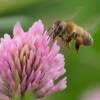GBH's Morning Edition asked our audience for weather and gardening questions, and meteorologist Dave Epstein graciously answered them on the air. This transcript has been edited for clarity.
Have a gardening or weather question for meteorologist Dave Epstein? Tweet him
@GrowingWisdom
, email us at
thewakeup@wgbh.org
, or text 617-300-2008.
“What’s with the lack of forsythia blooms this year? They seem to be going straight to green leaves! I usually cut a few branches early and bring them inside to force them and get some nice yellow in my kitchen but even those only had leaves. What happened this year?” — Tammy
The lack of blooms is likely because of this winter’s weather patterns, Epstein said.
“It's because of the lack of cold, then that extreme cold in February,” he said.
Plants were getting ready to bloom in the mild winter weather, only to be hit by a sudden freeze in February. While budding leaves, which tend to be hardier, survived, more sensitive flowers did not.
“That cold, it did a number on a lot of blooms,” Epstein said. “There’s no peach crop in New England this year because of it.”
Epstein said he’s seen a handful of forsythia blooms. And even without blooms, the forsythia plants are probably doing fine if leaves are coming in, he said.
“The plant itself is fine,” Epstein said. “Same thing on some of our early rhododendrons, same thing on some of the magnolias, some of the Yoshino cherries are not blooming at all this year.”
Same goes for rose bushes, Epstein said. He’s encouraging people to use a bit of liquid fertilizer on their rose bushes.
“I have Ivy covering most of my yard. It seems to have died over the mild winter. Do you know why this might be? And do you know how to mediate this?” — Maria in Somerville
Again, the culprit is probably a mild winter followed by sudden cold exposure, Epstein said. But don’t count that ivy out yet: It may still come back. At this point in the season, it’s best to wait and see, Epstein said.
“Don't get too drastic because some of it will come back,” he said. “The leaves and stuff were damaged. It looks horrible. But I think patience is going to be the key for many of us who have gardens and trees in our yards, because things will get a little better.”
He advised waiting until early June, when plants will have had more time to grow new leaves, especially if the region gets more rain.
“If things are still not leafed out, that's when you sort of say, okay, this one succumbed to the cold,” he said.








